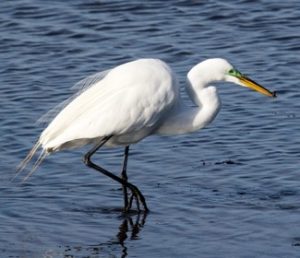Too many bags, bottles, cups and straws are made to be used just once and then discarded, often ending up as litter. Single-use plastic items are an especially big problem because they last a long time in the environment. Many of these items end up in the creeks and rivers that flow into Barnegat Bay. This harms marine life, spoils swimming and fishing, and pollutes the water today……and tomorrow.
No one wants to see a plastic bag or bottle floating by while swimming or clamming in Barnegat Bay, or a pile of wrappers next to your spot on the beach! We love Barnegat Bay and want to keep it healthy and clean for both us and the animals that make it their home. Go with reusable containers – Barnegat Bay is worth it!

Reuse and Get Past Single-Use Plastic
Bring Your Own Bag
Many plastic bags wind up in our waterways and the bay. For shopping and take-out food, bring your own reusable bag.
Bring Your Own Cup
Keep a reusable coffee cup or mug in your bag, at work or in your car.

Carry a Reusable Water Bottle
Plastic water bottles are one of the most commonly found items during community cleanups in the Barnegat Bay watershed. Invest in a reusable water bottle to cut waste and save money.
Use a Reusable Straw, or Skip the Straw
Plastic straws are also one of the most littered plastic items. Reusable straws are available in a variety of materials, including stainless steel and silicone. Skip the straw, or use a reusable one.
The Problem With Plastic

In 2018 alone, 35.7 million tons of plastic were generated in the United States. While plastic can be useful to preserve food or to package some items, it is important to understand the detrimental impacts it has on the environment, and what you can do to help reduce those impacts.
Plastic waste affects water quality, endangers plants and animals, and pollutes the outdoor spaces that we depend on for tourism and recreation. Plastic items are particularly concerning because of their tendency to persist in the environment.
Animals that become entangled in debris risk suffocating or drowning. Many species mistake plastic debris for food or inadvertently ingest it while feeding or swimming. Once ingested, the plastic can damage an animal’s digestive tract and interfere with its ability to feed, even leading to starvation.

Most plastic materials are petroleum-based. Chemicals, such as flame retardants and pigments, are often added to provide specific properties. When exposed to sunlight or other environmental factors, chemical toxins in plastics can be released into the soil and water.
Often, plastic pollution fragments into smaller plastic particles called “microplastics,” which are less than 5 mm in size. Ingestion of microplastic particles can expose aquatic life to the chemicals used to produce the plastic material itself as well as pollutants in the environment that tend to accumulate on plastic particles.
Visit the EPA Trash Free Waters website to learn more about the impacts of aquatic trash and what you can do.
New Jersey Law
On Nov. 4, 2020, New Jersey enacted a comprehensive new law banning single-use plastic bags. The law aims to reduce the quantity of single-use plastics and prevent plastic pollution in our state. Effective as of May 4, 2022, it prohibits retailers from providing single-use plastic bags and polystyrene foam food service products. Additionally, plastics straws are only provided to customers by request. Learn more about the law on the NJDEP’s Get Past Plastic website.

Thank you to the U.S. Environmental Protection Agency for its support in developing the Barnegat Bay is Worth More Than One Use campaign. Download the campaign poster here.

